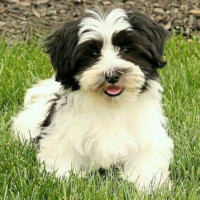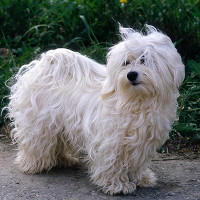Appearance of the Havachon
|
| The Havachon is a small but sturdy dog with dark-brown, intelligent eyes and a kind face. They have a round skull and hairy ears that hang from the head. They have a small black nose that is usually quite shiny. Their bodies are rectangular and their limbs are fairly short. The Havachon's tail curves elegantly over its back and is densely furred. The average adult Havachon measures between 23 and 36 cm and weighs between 4 and 7 kg. The Havachon's coat varies from dog to dog, and may feature the characteristic curls of its parent Bichon à poil frisé, or may more closely resemble the long, wavy coat of the Bichon havanais. While the Bichon à poil frisé will never be anything but white, the Havachon takes after their Havana parent in coat color and can have many coat colors, including black, gray, cream and white. It's not uncommon for a dog to have more than one color. |
Temperament of the Havachon
|
| One of the Havachons' greatest assets is their docile, playful personality. This characteristic has led to their ever-growing popularity, especially with families with young children. They'll grab almost anyone's attention, and are happiest when cuddled. They seem to rely on human companionship for their happiness and make incredibly loyal pets. Of course, this can sometimes be a problem, as these dogs really hate to be left alone. Separation anxiety is not uncommon, and it wouldn't be wise to choose a Havachon unless you're able to spend a lot of time with him every day. Curious and always ready to play, the Havachon is a fun addition to the family and will keep everyone entertained. Naive but intelligent, they'll keep owners on their toes and love to gaff. The Havachon is too good-natured to represent a serious danger as a guard dog, but it certainly has the ability to make a good watchdog and barks as soon as a new person arrives home. Highly adaptable, one of the advantages of owning a Havachon is that they don't need much space. Adapted to city life, this breed can be at home even in a small apartment. |
Needs and activities of the Havachon
|
| A Havachon needs a lot of exercise for a small dog. Daily walks in a park or on the beach are a good idea. Ball games in a fenced-in yard will keep him happy. These are good dogs for those living in a house or apartment, as they are adaptable but need daily exercise to prevent the formation of bad habits. A Havachon hates being alone, so it needs an owner willing to spend a lot of time with it. They're intelligent dogs who'll love learning tricks and practicing sports like agility, flyball and obedience training. |
Maintenance of the Havachon
|
| A Havachon is a hypoallergenic breed, suitable for allergy sufferers. They don't shed much, but they will need brushing two to three times a week to get rid of mats. Your Havachon will probably need grooming every six weeks or so to stay healthy, and may need a professional groomer. Bathing is recommended only when necessary and with a good dog shampoo to prevent skin irritation. Try to brush his teeth every day to avoid dental problems, and check the nails regularly to see if they need trimming. Ears should also be checked weekly for dirt or burrs and can be wiped with a damp absorbent cotton pad. |










 English (United Kingdom)
English (United Kingdom)